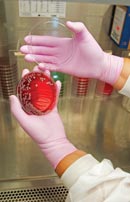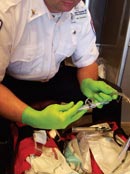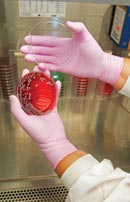
When Illness Strikes
Hygienic practices, along with NFPA 1999-compliant PPE, will provide protection.
- By Donald F. Groce
- Apr 01, 2010

Providing employees with disposable gloves made from Nitrile offers an excellent barrier to infectious diseases.
When illnesses strike — such as seasonal flu, H1N1, or Methicillin Resistant Staphylococcus Aureus (MRSA) — how do you protect your workers and do your part to stop contagious infections from spreading to unsuspecting workers and crippling the productivity of your organization, with high absenteeism from sick leave or mass panic?
With the second wave of infections from swine flu (H1N1) came many preparatory measures worldwide to prevent the spread and to protect from infection. Many of the preparatory measures have application in all outbreaks and in everyday life to keep individuals safe and healthy.
H1N1 at this Point
By the first quarter of 2010, the H1N1 pandemic has come in at least two distinct surges as the first global pandemic since the 1968 Hong Kong flu. A Nov. 8, 2009, worldwide update from WHO stated, "206 countries and overseas territories/communities have officially reported over 503,536 laboratory-confirmed cases of H1N1 infection, including 6,250 deaths."
Most health surveillance organizations believe the peak for H1N1 cases has passed for now. The incidence of death and severe, life-threatening conditions from H1N1 has been lower than what was anticipated for this second surge. Thankfully, the illness has been seen in some as less severe than the seasonal flu. Most research indicates the virus will be around for a while, with surges and declines in the number of cases.
Because treatment of H1N1 is the same as for seasonal flu, most health care providers treated all influenza cases the same and did not perform the additional test specific for H1N1. Estimates of the virulence and the spread of H1N1 caused great alarm, with many businesses and municipalities preparing for up to one-third of the workforce to be infected or to be out caring for sick children or family members.
The late arrival of the vaccine also caused huge concern for the health care community at large.
Not only is H1N1 still a great concern as it continues to spread worldwide at a much lower rate since the second surge has come and gone, but also other infectious diseases have the potential to infect the workplace.
MRSA is also pandemic in nature and continues to spread. It can be life-threatening, and it is persistent and very difficult to get rid of.
Worker Protections
How do you protect your workers from such illnesses? Hand protection off ers the most obvious answer. Providing employees with disposable gloves made from Nitrile off ers an excellent barrier to infectious diseases. Every employee needs to be reminded of respiratory etiquette, where coughs and sneezes are covered with a tissue or sleeves. Tissues and articles known to be contaminated should be discarded appropriately.
With the H1N1 pandemic and MRSA, you can't help but notice the prevalence and availability of hand sanitizers in workplaces, hospitals, and schools. No doubt, this practice also has helped to curtail the spread of germs. Frequent washing of hands, using gloves and hand sanitizers, respiratory etiquette, and common-sense hygienic practices will help to make these illnesses not as widespread and may keep you from getting them.
Social distancing is the practice of partially isolating persons who are sick until they are well enough to be around colleagues. This practice should be the responsibility of both the sick individual and the employer who know about a sick employee.
CDC has recommended that anyone with a fever related to H1N1 should remain at home until 24 hours aft er the fever has subsided. This practice is also applicable to other infectious diseases. Employers should be willing to excuse and not dock an employee who has to stay at home to keep from spreading an infection and causing more employees to be out.
A lot of statistical data on infectivity and susceptibility of various groups has been published regarding H1N1 potential and is applicable to most other illnesses. The risk groups that are most susceptible for every infectious disease include:
- Pregnant women
- Pregnant women who work in education, child care, or health care
- Health care providers
- Laboratory workers
- Schools
- Day care and nursery schools
- Parents of young children
- People age 65 or older
- Immuno-suppressed individuals
- HIV-infected patients
- Patients with auto-immune disease
- Cancer patients
- Transplant patients
- People with diabetes
- People with arthritis
- Children under age 5
- African-Americans
- Chronic Obstructive Pulmonary Disease sufferers
People who travel are also at greater risk for contracting infectious diseases and spreading them. You should always consider frequent hand washing and the use of hand sanitizers when traveling. You should distance yourself from those who appear sick, when feasible. You should not touch your face any more than necessary.
With MRSA, athletic teams and schools are the new breeding ground for this infection, where in the past it was almost exclusively limited to hospital-borne contact. You should wash every item of athletic clothing and shower as oft en as possible to keep the breeding ground for MRSA at a minimum. Hand sanitizer and disposable gloves are very helpful when cleaning up around sports teams' facilities, locker rooms, and health clubs.
Possible Mutations

MRSA is also pandemic in nature and continues
to spread. It can be life-threatening,
and it is persistent and very diffi cult to get
rid of.
Thus far, H1N1 infections have not caused as many deaths as regular seasonal flu, but there is fear the virus will change or mutate during subsequent waves as it spreads across the globe. A changed version of the H1N1 virus could produce a much deadlier, treatment-resistant strain that could render previous immunizations useless.
An example of such change in a global pandemic occurred in 1918 when the Spanish flu killed 50 to 100 million people worldwide. Spanish flu was an avian influenza with a first wave that was not all that deadly. Later, when the virus mutated, the deadliest wave of pandemic occurred.
Being Prepared
Much of the preparation involves personal hygiene and common-sense avoidance of germs, including:
- Respiratory etiquette (coughing into your sleeve)
- Personal protective equipment, such as gloves and masks
- Social distancing from sick individuals
- Staying home from social events
- Washing hands frequently
- Using hand sanitizer
The H1N1 experience in New York City proved that NFPA 1999-compliant personal protective equipment works. NFPA 1999, Standard on Protective Clothing for Emergency Medical Operations, sets the minimum requirements for protective clothing that provides protection from bodily fluids and bloodborne pathogens.
In order to pass the testing for compliance with NFPA 1999, gloves have to pass ASTM F 1671, Standard Test Method for Resistance of Materials Used in Protective Clothing to Penetration by Blood-Borne Pathogens Using Phi-X174 Bacteriophage Penetration as a test system. The model viral particle utilized for testing is 27 nanometers in size and is smaller than the 100-nanometer H1N1 swine flu virus. The test data show that NFPA 1999-compliant PPE does not allow the virus to penetrate. By requiring the use of these NFPA 1999-certified products, New York City protected its EMS providers, enabling them to sustain their continued eff orts to deliver critical services to those in need.
At workplaces across the country, companies and government agencies are making similar decisions as to the best way to prevent the spread of H1N1. In many cases, the decision is being made to have workers wear disposable gloves that can protect them from contact with this global virus. Hygienic practices, along with appropriate personal protective equipment, will provide protection from other illnesses. These just make good sense for the overall hygiene of the workplace, homes, and schools.
About the Author
Donald F. Groce, Showa-Best Glove, is a technical
product specialist and a research chemist.
Before joining Showa-Best Glove, he worked
for the U.S. Centers for Disease Control and
Prevention on chemical toxicology studies that
included the Agent Orange Study. He is a noted
speaker and expert on a variety of occupational
and workplace hazards, including latex allergies
and chemical exposure-related illnesses.
He is a part of the local Citizen’s Meth Task
Force and serves on the NFPA 1999 Technical
Committee and the American Industrial Hygiene
Protective Clothing Committee.